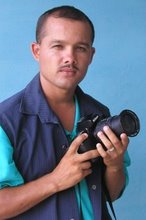Photos: Amauris Betancourt.
 It happened in the
It happened in the 
Varela wore black (as he always does) and had five talented musicians keep him company. Singer Diana Fuentes sticks out. Down, before the stage, a sea of young people (teenagers and thirty-and-odds people) and some other from different ages. The first song was 25 thousand lies on the truth. The last The woodcutter without forest, a usual request from fans included in his CD Like a fish (1995).
The first time I listened to Carlos Varela, Like a fish was an underground hit. He was not played in the radio when I got to  The poster, on a street lamp post in Reina street, promoted a concert and, according to what I knew many years later, it had turned out to be legendary due to the crowd it brought together and because, for the first time, he was thrown coins at when singing Coins to the air as a promotion to the video clip where the very Grethel, the muse whom Varela saw through Jim Morrison's eyes, was dancing. It had happened almost one year before.
The poster, on a street lamp post in Reina street, promoted a concert and, according to what I knew many years later, it had turned out to be legendary due to the crowd it brought together and because, for the first time, he was thrown coins at when singing Coins to the air as a promotion to the video clip where the very Grethel, the muse whom Varela saw through Jim Morrison's eyes, was dancing. It had happened almost one year before.
I found that poster many times those days. The CD Like a fish rendered a successful production with fabulous songs like Small dreams, Family pictures, Habaname or Like an angel. He included also harsh criticisms to Cuban reality like Politics does not fit in the sugar bowl or The woodcutter without forest. It was not difficult to understand why his songs were radioed, “only sometimes”, (if by any chance they were radioed in the nineties), even though his friend and protector Silvio Rodríguez had said that “the ones plotting against Carlos Varela erred, because they think him very hypercritical."
 A curious thing turned out to me with Varela. When I got to
A curious thing turned out to me with Varela. When I got to It was logical, I thought: The hardest years seemed to have gone, and with them all poetical Carlos Varela's amphibology met an end. I was mistaken again. He came out with Seven (2 003) and so dreadful lyrics like the one adorning the melody in Behind the window-glass, a song where he came back stabbing us with a cold and cruel sensibility shouting: “The ones that fled cry, the ones that stay cry more”.
 That was the Carlos Varela I had always been interested in. The troubadour whose lyrics of love stem from reality and its symbols and circumstances. Now, after having turned 46, he has started this national tour to promote his new work, entitled It is not the end. It is not either for his career: He is a mature man; Voice and fans keep him company. Last night (Saturday, April 18), the
That was the Carlos Varela I had always been interested in. The troubadour whose lyrics of love stem from reality and its symbols and circumstances. Now, after having turned 46, he has started this national tour to promote his new work, entitled It is not the end. It is not either for his career: He is a mature man; Voice and fans keep him company. Last night (Saturday, April 18), the  The image in the poster stayed there, two or three years right after the XXI century had already begun. I remember they were four pieces of a scratched paper surviving time when I saw it last. I was heading down
The image in the poster stayed there, two or three years right after the XXI century had already begun. I remember they were four pieces of a scratched paper surviving time when I saw it last. I was heading down 

No hay comentarios.:
Publicar un comentario